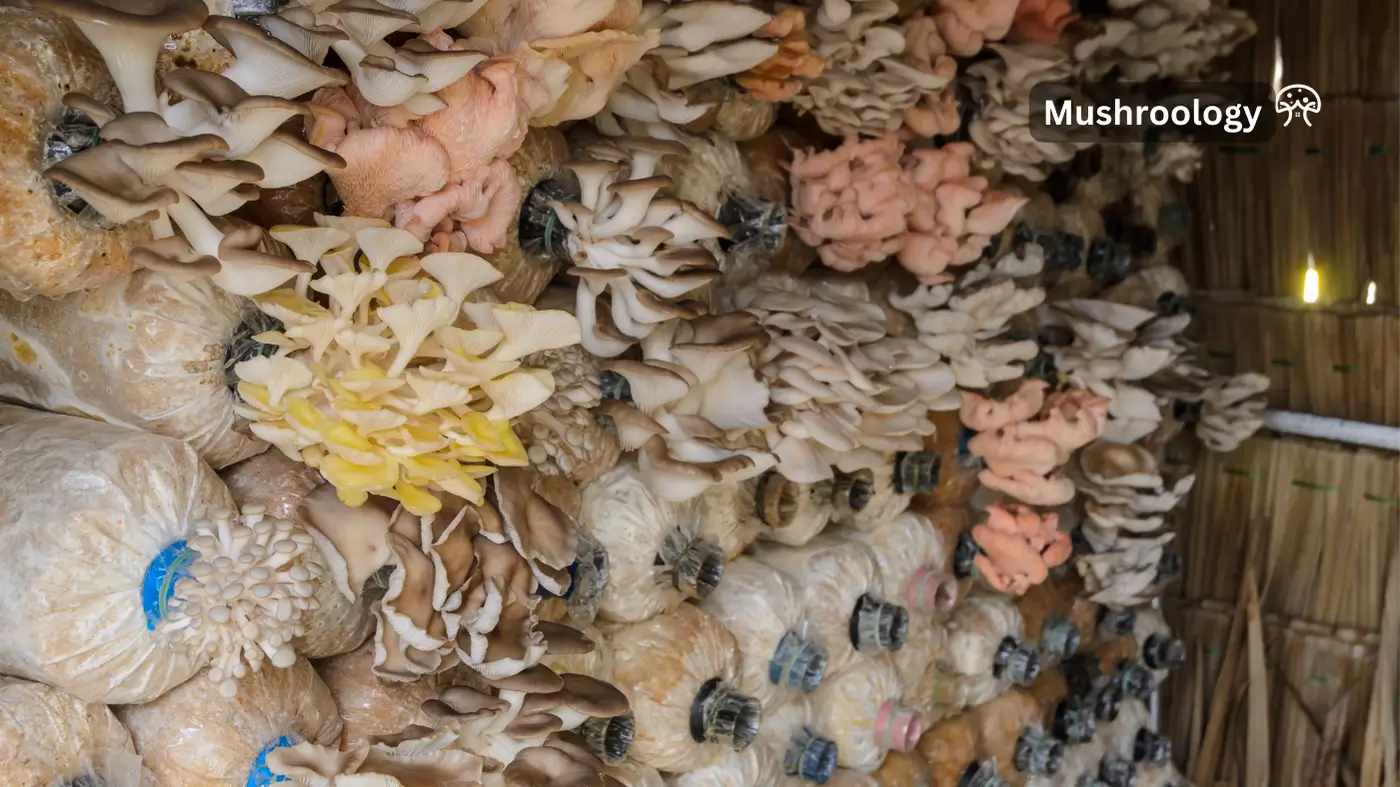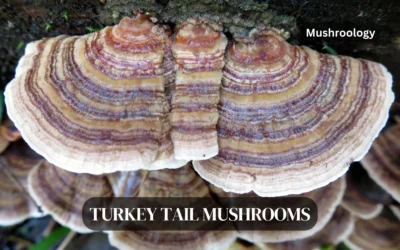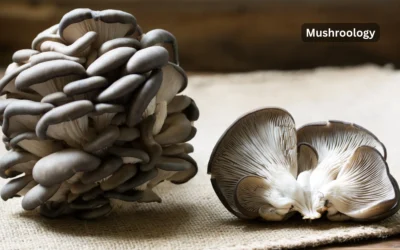Mushroom farming, also called mushroom cultivation, is a fascinating and rewarding agricultural practice that’s gaining popularity worldwide. This unique type of farming involves growing mushrooms commercially or at home, making it a versatile option for everyone from hobby gardeners to professional farmers.
Unlike traditional farming, mushroom cultivation doesn’t require extensive farmland. You can even start mushroom farming indoors, in a garage, basement, or small garden space, making it perfect for urban areas. One of the most appealing aspects of mushroom farming is that it requires a minimal investment, uses fewer resources like water and land, and offers a quick turnaround with rapid growth cycles.
Benefits of mushroom farming
Mushroom farming offers numerous advantages that make it an attractive option for both newcomers and experienced growers. Some key benefits include:
- Quick Growth Cycle: Mushrooms typically have a short cultivation period, ranging from a few weeks to just a couple of months. This quick turnaround allows farmers to enjoy frequent harvests and a steady income stream.
- High Yield in Small Spaces: One of the greatest advantages of mushroom farming is its ability to produce large yields in limited spaces. Small indoor setups, vertical farming techniques, or mushroom farming bags can maximize output even in compact environments.
- Low Startup Costs: Compared to traditional agricultural practices, mushroom farming requires significantly lower initial investments. Basic mushroom farming equipment and supplies such as spawn, substrate, and grow containers are affordable and easily accessible.
- Sustainable Agricultural Practice: Mushroom cultivation promotes environmental sustainability by using agricultural by-products like straw, sawdust, coffee grounds, and compost. This practice not only recycles waste but also reduces environmental pollution, making mushroom farming eco-friendly.
Overall, mushroom farming represents an accessible, sustainable, and profitable agricultural method suitable for various scales of production, from small home operations to commercial ventures.
Types of mushrooms ideal for farming
There are numerous mushroom varieties suitable for farming, each with unique cultivation requirements and market opportunities:
- Button Mushrooms: Also known as white mushrooms, button mushrooms are the most common variety cultivated worldwide. They are easy to grow and highly popular.
- Oyster Mushrooms: Known for rapid growth and adaptability, oyster mushrooms come in various colors and thrive on substrates like straw or sawdust.
- Shiitake Mushrooms: These mushrooms have a meaty texture and rich flavor, making them highly desirable in gourmet cuisine. Shiitake mushrooms are typically grown on hardwood logs or sawdust blocks.
- Portobello Mushrooms: Known for their large caps and meaty texture, portobello mushrooms are popular for grilling and other culinary uses. They are grown similarly to button mushrooms but harvested later.
Understanding these mushroom types and their specific growth needs can significantly enhance your success and profitability in mushroom farming.
Indoor vs outdoor mushroom cultivation
One of the first decisions aspiring mushroom growers must make is whether to cultivate their fungi indoors or outdoors. Each approach has its own advantages and challenges.
Indoor and outdoor cultivation each have distinct advantages and challenges. The choice between the two depends on factors like climate, available space and resources, target markets, and the specific mushroom species being grown.
Indoor mushroom cultivation
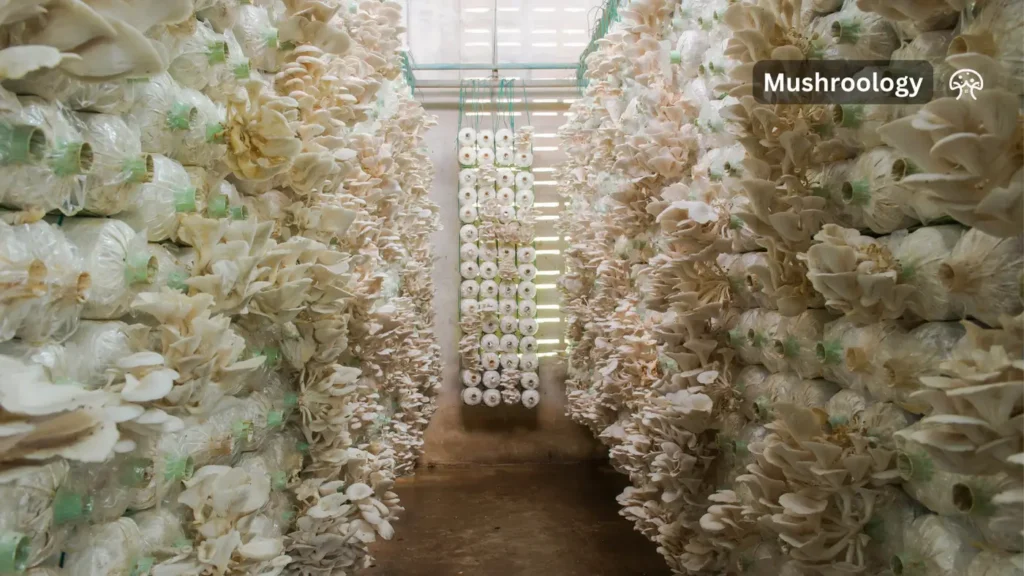
Indoor cultivation allows for greater control over environmental conditions, enabling year-round production regardless of outdoor weather.
Benefits of indoor growing include:
- Consistent, controllable environment for optimal growth (temperature, humidity, light, CO2, etc.)
- Protection from pests, diseases, and contaminants
- Ability to grow a wider variety of mushroom species in separate areas
- Generally faster growth cycles and higher yields per square foot
However, indoor setups require more equipment, infrastructure, and energy inputs compared to outdoor methods. Key considerations for indoor growing:
- Need for specialized equipment like HVAC, humidifiers, lighting, shelving
- Significant startup costs and ongoing expenses for facilities and utilities
- Stricter attention to hygiene and sanitation to prevent contamination
- More labor and day-to-day maintenance requirements
Indoor cultivation can be adapted to various spaces like grow rooms, basements, barns, garages, warehouses, and shipping containers. This flexibility makes it accessible to both rural and urban growers.
Outdoor mushroom cultivation
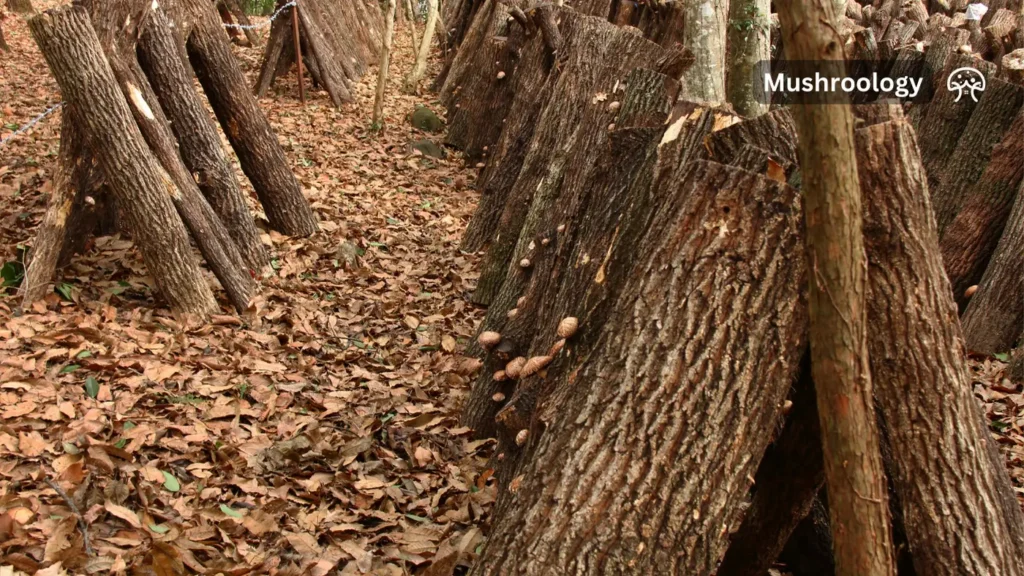
Outdoor cultivation involves growing mushrooms in more natural settings, aiming to recreate the conditions where they thrive in the wild. Outdoor growing has advantages like:
- Lower startup and operating costs by utilizing natural resources
- More sustainable and environmentally friendly production
- Well-suited for mushrooms that prefer outdoor substrates like logs and stumps
- Can be integrated with agroforestry and permaculture systems
However, outdoor cultivation has less control over growing conditions and other limitations:
- Seasonal constraints and weather dependency impacting consistency
- Lower yields and slower growth cycles compared to indoor
- Increased exposure to pests, diseases, and competitors
- More limited range of species that can be grown reliably
Common outdoor cultivation methods include log inoculation, outdoor beds, and the use of shade structures. Shiitake and oyster mushrooms are popular choices for outdoor growing.
Hybrid approaches on mushroom cultivation
Some growers utilize both indoor and outdoor cultivation in hybrid systems to get the benefits of each. For example:
- Starting indoors for spawn production then moving outdoors for fruiting
- Bringing outdoor logs inside to force fruiting and extend seasons
- Indoor lab and spawn work combined with outdoor bed production
In the end, the choice between indoor, outdoor, or hybrid cultivation depends on the unique goals, resources, and constraints of each grower. Factors like target markets, local climate, available substrates, budget, and the chosen mushroom species all influence which method is most practical and profitable for a given situation.
Low-Tech vs High-Tech Mushroom Cultivation
Another key consideration for mushroom growers is whether to use low-tech or high-tech cultivation methods. This choice often depends on the scale of production, available resources, target markets, and the grower’s goals and preferences.
Low-Tech Mushroom Cultivation
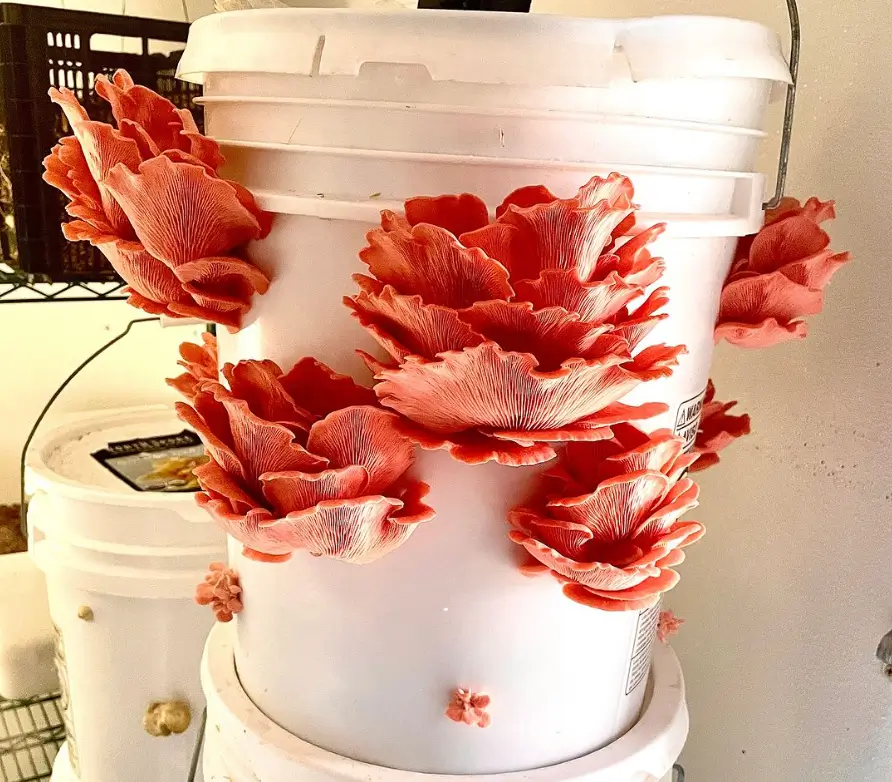
Low-tech methods are simple, affordable, and accessible for home growers and small-scale producers. They typically involve inoculating natural substrates like logs, stumps, straw, or wood chips with mushroom spawn. The mycelium colonizes the substrate and fruits when conditions are favorable. Some popular low-tech methods include:
- Log inoculation: Drilling holes in freshly cut hardwood logs and inserting spawn plugs or sawdust spawn
- Straw beds: Pasteurizing straw, mixing in spawn, and letting it colonize in bags or beds
- Wood chip beds: Inoculating wood chips or sawdust and allowing mycelial growth outdoors
Low-tech methods often have lower yields and longer growth cycles than high-tech approaches, but they are more beginner-friendly and have minimal startup costs. They also tend to be more environmentally sustainable, utilizing natural and waste materials with less energy inputs.
Advantages of low-tech cultivation include:
- Lower startup and operating costs by using inexpensive, locally available substrates
- Accessible and beginner-friendly, requiring less specialized equipment and facilities
- More sustainable and eco-friendly, aligning with permaculture and agroforestry practices
- Well-suited for outdoor cultivation and integrating into diversified farming systems
However, low-tech methods also have some limitations:
- Lower yields and less predictable harvests compared to high-tech setups
- Longer growth cycles and seasonal constraints, especially for outdoor cultivation
- Limited control over environmental conditions, leading to more crop variability
- Narrower range of mushroom species that can be reliably cultivated with low-tech methods
High-Tech mushroom Cultivation
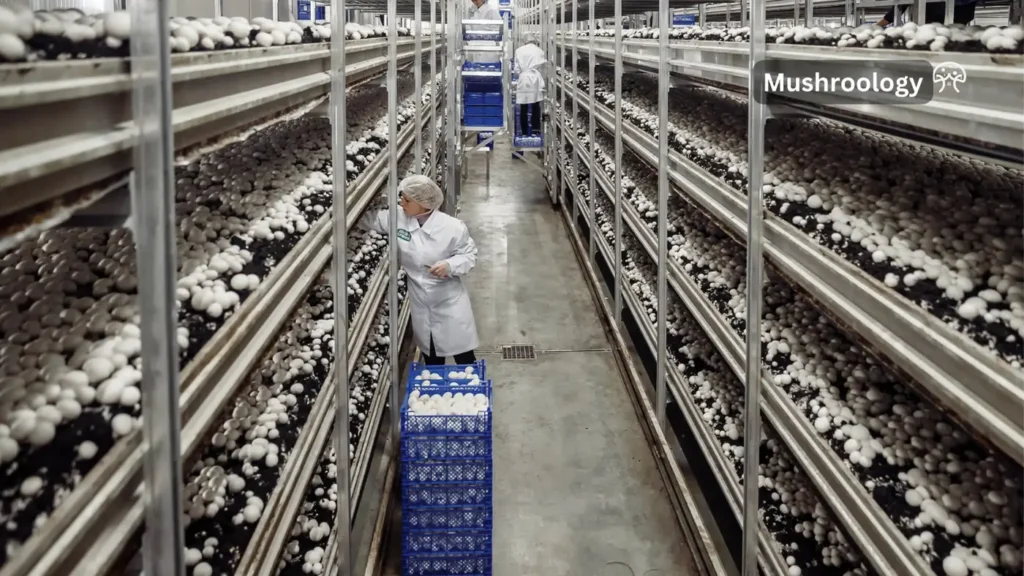
High-tech cultivation leverages modern equipment, facilities, and technologies to optimize growing conditions and maximize productivity. This approach is common in commercial mushroom farms, indoor growing operations, and research settings. High-tech methods often involve:
- Automated environmental controls for temperature, humidity, CO2, and light
- Precision substrate preparation, supplementation, and sterilization
- Laminar flow hoods, clean rooms, and lab equipment for sterile culture work
- Computer monitoring systems, sensors, and data analytics for optimizing conditions
The benefits of high-tech cultivation include faster growth cycles, higher yields, improved consistency, and reduced contamination risk. These systems enable year-round production in climate-controlled indoor environments. High-tech approaches also allow for cultivating a wider variety of gourmet and medicinal mushroom species.
Advantages of high-tech mushroom farming include:
- Higher yields, shorter growth cycles, and more predictable harvests
- Precise control over environmental conditions for optimal growth
- Ability to grow a diverse range of mushroom species indoors year-round
- Reduced contamination risk through advanced pasteurization and air filtration
- Potential for automation, mechanization, and scaling up production
However, high-tech setups also have some drawbacks:
- Higher startup costs for equipment, facilities, and infrastructure
- Increased operating expenses for energy, materials, and skilled labor
- More complex systems requiring specialized knowledge and technical skills
- Potentially less sustainable due to reliance on energy inputs and synthetic materials
In practice, many mushroom farms utilize a combination of low-tech and high-tech methods tailored to their goals, resources, and market demands. For example, a farm may use outdoor log cultivation for seasonal shiitake production while also operating an indoor facility with climate control and automated systems for oyster and lion’s mane mushrooms.
The choice between low-tech and high-tech cultivation ultimately depends on factors such as the grower’s experience level, available capital, target species and markets, site conditions, and personal values around sustainability and self-sufficiency. By understanding the pros and cons of each approach, growers can make informed decisions to design mushroom cultivation systems that align with their unique circumstances and objectives.
Choose the right mushroom cultivation method for you
With so many options available, how do you decide which cultivation method is best for your situation? Consider the following factors:
- Goals: Are you growing for personal use, as a hobby, or for commercial purposes? Your production goals will influence the scale and complexity of your setup.
- Resources: Evaluate your available space, time, budget, and skills. Choose a method that aligns with your resources and constraints.
- Species: Different mushroom species have specific substrate and environmental preferences. Research the needs of the varieties you want to grow and select compatible methods.
- Climate: If you live in an area with extreme temperatures or limited outdoor space, indoor cultivation may be more practical. Outdoor methods work well in temperate regions with ample shade and moisture.
Common challenges in mushroom farming
Mushroom farming is rewarding, but it does come with certain challenges. Successfully growing mushrooms requires careful management, attention to detail, and prompt solutions when problems arise. Being aware of common issues and how to solve them will ensure your mushroom farming venture remains productive, profitable, and sustainable.
1. Contamination Issues
Contamination by mold, bacteria, or other unwanted fungi is one of the most common challenges in mushroom cultivation. Contaminants can quickly destroy an entire mushroom crop by competing with mushrooms for nutrients, inhibiting growth, and causing health hazards.
Solutions:
- Maintain Strict Hygiene:
Regularly sanitize growing areas, equipment, and containers using disinfectants such as diluted hydrogen peroxide or bleach solutions. - Sterilize or Pasteurize Substrate:
Ensure substrates (like straw, sawdust, or compost) are thoroughly sterilized or pasteurized to eliminate unwanted organisms before introducing mushroom spawn. - Monitor Spawn Quality:
Purchase high-quality mushroom spawn from trusted suppliers to reduce contamination risks.
2. Pest and Disease Management
Like other farming practices, mushroom cultivation can attract pests such as mushroom flies, mites, gnats, slugs, or diseases that harm mushroom growth. These pests and diseases can significantly reduce yield and affect mushroom quality.
Solutions:
- Regular Inspections:
Frequently check growing areas to detect early signs of pests and disease. Early detection makes treatment easier and minimizes damage. - Physical Barriers and Screens:
Use fine-mesh screens, doors, or insect-proof netting to prevent entry of pests into mushroom growing rooms. - Natural Pest Control:
Apply safe biological control methods like beneficial insects (predatory mites) or natural repellents such as neem oil or diatomaceous earth, minimizing chemical use and ensuring mushroom safety.
3. Inconsistent Environmental Conditions
Mushrooms require very specific environmental conditions to thrive, including optimal temperature, humidity, ventilation, and lighting. If these conditions fluctuate or become unsuitable, mushrooms may not grow properly or yield high-quality crops.
Solutions:
- Install Climate Control Systems:
Use climate control equipment such as humidifiers, air conditioners, heaters, fans, or misting systems to maintain consistent and optimal growing conditions. - Regular Monitoring:
Use accurate monitoring tools like hygrometers, thermometers, or automated environmental controllers. Regularly log conditions to quickly adjust and maintain stable growing environments. - Proper Ventilation:
Ensure adequate airflow to prevent stagnant, moist conditions that could foster contamination or reduce mushroom quality. Good ventilation also reduces CO₂ build-up, which negatively impacts mushroom growth.
4. Poor Mushroom Yield or Slow Growth
Sometimes mushroom yields are lower than expected or growth is slower than anticipated, resulting in frustration and financial setbacks.
Solutions:
- Quality Spawn and Substrate:
Always use high-quality spawn from reputable sources. Ensure substrates are nutritious, properly prepared, and optimized for your specific mushroom type. - Correct Spawn-to-Substrate Ratio:
Follow recommended spawn ratios carefully. Too little spawn can result in slow or uneven colonization, reducing overall yield. - Maintain Ideal Growth Conditions:
Double-check and maintain ideal temperatures, humidity levels, and lighting specific to your mushroom variety, as different mushrooms have varying environmental requirements.
5. Difficulty in Harvest Timing
Knowing exactly when and how to harvest mushrooms is critical. Harvesting too early or too late can reduce mushroom quality, shelf life, and market value.
Solutions:
Frequent Harvest Checks:
Regularly inspect mushrooms, ideally daily, to harvest at the perfect time, ensuring maximum freshness, shelf life, and quality.
Learn Mushroom Maturity Indicators:
Educate yourself on the visual indicators of mushroom maturity for the specific varieties you’re growing. For instance, oyster mushrooms should be harvested just as caps begin to flatten, while shiitake mushrooms are harvested when caps fully open but before they flatten entirely.
Profitability and Marketing of Mushroom Farming
Mushroom farming can be highly profitable, provided you approach it strategically and understand your market clearly. Many growers enter mushroom farming because of its attractive earning potential, minimal startup costs, and the increasing consumer demand for mushrooms. To turn your mushroom farm into a thriving business, it’s essential to understand profitability factors and adopt effective marketing strategies.
Understanding Mushroom Farming Profitability
The profitability of mushroom farming largely depends on several key factors, including mushroom variety, yield per harvest, production costs, local market demand, and pricing strategies. For instance, varieties like Oyster, Shiitake, and Portobello mushrooms typically command higher market prices due to their popularity and culinary uses, resulting in greater profit margins compared to common button mushrooms.
To enhance profitability, you should consider:
- Selecting High-Value Mushrooms:
Growing gourmet mushrooms like Shiitake, Oyster, and specialty medicinal varieties can significantly boost profits since consumers and restaurants are willing to pay premium prices for these mushrooms. - Cost Management:
Efficiently managing your cultivation practices, minimizing waste, optimizing resources, and effectively using inexpensive substrates (e.g., straw, sawdust, coffee grounds) helps keep production costs low. - Scaling Your Business Wisely:
Begin small to test your market and gradually expand as your expertise and customer base grow. Investing in expansion too early can risk your profitability if market demand doesn’t match production capacity.
Strategies for Marketing and Selling Mushrooms
Effective marketing is crucial for mushroom farmers aiming to succeed commercially. Even with high-quality mushrooms, your farm’s profitability largely depends on how well you reach your target customers. Here are several proven marketing strategies:
- Identify Your Target Market:
Your target audience can range from local restaurants, supermarkets, farmer’s markets, health-conscious consumers, gourmet chefs, to online buyers. Clearly identifying who you are selling to will streamline your marketing efforts. - Branding and Packaging:
Attractive, professional packaging and consistent branding can significantly boost your product’s appeal. Include labels with information about mushroom type, freshness date, nutritional benefits, and usage tips to enhance consumer trust. - Online Presence and Social Media:
Create a user-friendly website and maintain active social media profiles to showcase your mushroom products, farming processes, recipes, and customer testimonials. Platforms like Instagram, Facebook, and Pinterest can attract customers who value fresh, organic, and locally grown foods. - Farmers’ Markets and Community Engagement:
Selling mushrooms at local farmers’ markets or community-supported agriculture (CSA) programs can rapidly build a loyal customer base and increase brand visibility. Engaging directly with consumers at these venues also offers valuable feedback and helps build relationships within the community. - Partnerships with Local Restaurants and Stores:
Establish direct relationships with local restaurants, specialty stores, and supermarkets that value fresh, locally sourced produce. Restaurants often seek reliable mushroom suppliers for their menus, creating steady and consistent demand for your products. - Value-Added Products:
Diversify your product offerings with dried mushrooms, mushroom seasoning blends, mushroom kits, or gourmet mushroom-based sauces. Value-added products have longer shelf life, higher profit margins, and open additional market opportunities.
Exploring Mushroom Farming Business Opportunities
With the growing interest in organic, nutritious, and sustainably produced foods, mushroom farming offers numerous entrepreneurial opportunities:
- Wholesale Supply:
Become a trusted wholesale supplier to grocery chains, restaurants, catering businesses, or specialty markets. - Mushroom Farming Kits:
Market mushroom growing kits to hobby gardeners, families, or educational institutions, allowing consumers to experience mushroom cultivation at home. - Educational Workshops and Tours:
Offer farm tours or workshops teaching individuals and schools about mushroom cultivation, health benefits, and culinary uses. This approach not only generates additional income but also strengthens your brand as an expert in the field.
By carefully combining effective production practices, smart financial management, targeted marketing, and exploring diverse business opportunities, mushroom farming can become a sustainable and profitable business venture.

